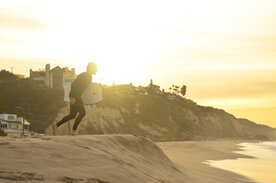

The mantra of Slip, Slop, Slap and Wrap for protection from the damaging rays of the sun still prevails as top advice. Incorporating this advice means the following factors must be considered when planning for exercising outside;
In New Zealand during the months of September through to April/May the Ultra Violet levels are high (3 or above) and if any activity is done between the hours of 10 am and 4 pm outside sun protection is crucial. Outside of these hours risk still exists at a lower level and protection is still advised. A sun protection alert for specific towns or cities can be found at http://sunsmart.org.nz/sun-protection-alert.
Opting to exercise in the shade where possible is ideal for providing extra protection as is avoiding reflective surfaces such as water and concrete that can also cause sunburns. Avoiding traffic filled areas is also not only good for oxygen quality but reduces the danger of not being seen by drivers due to glaring sun.

Clothing that minimizes the amount of skin exposed to the sun is always recommended but can be difficult to adhere to in the heat. Hats, particularly of the broad brimmed, bucket or legionnaire styles, are also important as areas such as the face, back of neck and tops of ears are all common places for sunburns. Eyes, eyelids and the surrounding skin also need protection as the sun can cause irritation, increased risk of cataracts and inflammation so sunglasses of the wrap around, close fitting styles with UV protection are recommended.
SPF stands for Sun Protection Factor and is a measure of how well the skin is protected from the sun when it is applied. Broad spectrum sunscreens filter two of the three types of UV radiation produced by the sun (UVA or aging rays and UVB or burning rays). Sunscreen needs to be applied 20 minutes before sun exposure with at least ½ teaspoon to each arm, and to the face (including the ears and neck); and at least a teaspoon to each leg, the front of body, and the back of body. When exercising outdoors it is recommended to use a sunscreen designed for sport and to reapply at least every two hours to ensure consistent protection.

The Cancer Society New Zealand advises that SPF30 sunscreen with AS/NZ 2604 standard on the label is sufficient for sun protection if applied correctly. When correctly following the instructions on the label, SPF30 filters 96.7% of UV radiation. SPF50+ filters 98% of UV radiation. Higher sunscreens do not mean longer periods of protection application and reapplication remains the same.
Additional risks when exercising outdoors include dehydration so ensure water is available to drink at regular intervals and when exercising vigorously for more than 2 hours ensure to replenish with electrolytes. It is also essential to consider activities wisely as pedaling on a recumbent bike daily for an hour does not automatically mean the ability to mountain bike for the same period of time.